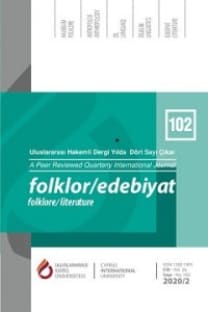GILGAMIŞ DESTANI VE TİTANLArIN SAVAŞINDA KAHrAMANIN YOLCULUĞU
Hero's Journey ın the Epıc of Gılgamesh and the Clash of the TITANS
___
- Andromeda, [2016], https://en.wikipedia.org/wiki/Andromeda_(mythology).
- Arketipler, [17.08.2016], http://www.psikolik.com/threads/analitik-psikoloji-arketipler.797.
- Armstrong, K. (2005). Mitlerin Kısa Tarihi, İstanbul: Merkez Yayıncılık.
- Augustine of Hippo, [2016], https://en.wikipedia.org/wiki/Augustine_of_Hippo.
- Beacham, T., Hay, P., Manfredi, M. (2010). Titanların Savaşı, ABD: Warner Bros. Entertainment.
- Bes, [01.09.2016], https://en.wikipedia.org/wiki/Bes.
- Canavar, [2016], http://www.etimolojiturkce.com/kelime/canavar.
- Campbell, J. (1949). The Hero with a Thousand Faces, Kaliforniya: New World Library.
- Campbell, J. (2010). Kahramanın Sonsuz Yolculuğu, İstanbul: Kabalcı Yayınevi.
- Campbell, J., Moyers B. (2013). Mitolojinin Gücü, İstanbul: Mediacat Kitapları.
- Cetus, [2016], https://en.wikipedia.org/wiki/Cetus_(mythology).
- Dundes, A. (2006). Halk Kimdir?. Halk Biliminde Kuramlar ve Yaklaşımlar-1. Ankara: Geleneksel Yayıncılık.
- Epic of Gilgamesh, [2016], https://en.wikipedia.org/wiki/Epic_of_Gilgamesh.
- Erhat, A. (1996). Mitoloji Sözlüğü, İstanbul: Remzi Kitabevi.
- Fatih'in İstanbul'a Girişi, [2015], https://en.wikipedia.org/wiki/Mehmed_the_Conqueror#/ media/File: Zonaro_GatesofConst.jpg.
- Fetih Tablolarını Kim Yaptı?, [2016], http://www.trthaber.com/haber/kultur-sanat/fetihtablolarini-kim-yapti-1784.html.
- Fontenrose, J. E. (1959). Python: A Study of Delphic Myth and its Origins, Kaliforniya: University of California Press.
- George, A. (1999). The Epic of Gilgamesh - The Babylonian Epic Poem and Other Texts in Akkadian and Sumerian, Londra: Penguin Books.
- Gezgin, İ. (2009). Gılgamış - Kültürlenme Sürecinin Mitik Kahramanı, İstanbul: Alfa Basım Yayım.
- Hades, [2016], https://en.wikipedia.org/wiki/Hades.
- Heaney, S. (2001). Beowulf, akt. sabitfikir.com [16.08.2016], New York: W. W. Norton & Company.
- İştar, [2015], https://tr.wikipedia.org/wiki/%C4%B0%C5%9Ftar James, H. (1884). The Art of Fiction, London: Longman's Magazin.
- Jung, C. G. (1997). Collected Works Vol.9, çev. E. Gürol, İstanbul: Payel Yayınları.
- Kahraman, [2016], http://www.etimolojiturkce.com/kelime/kahraman.
- Koçak, A. (2016). Mit ve Ritüel Dünyasından Gılgamış Destanı'na Boğa Kültü. Frankofoni.
- c. 29: 174, 176. Kearney, R. (2012). Yabancılar, Tanrılar ve Canavarlar, çev. B. Özkul, İstanbul: Metis Yayınları.
- Kerenyi, K. (1959). The Heroes of the Greeks, London: Thames and Hudson.
- Kraken, [2016], https://en.wikipedia.org/wiki/Kraken.
- Lee, S. (2005). The Hero's Journey in Two Classic Stories, [17.05.2013], http://web.archive. org/web/
- 20130701055516/http://qui-gonline.org/features/herosjourney.htm.
- Medusa, [2016], https://en.wikipedia.org/wiki/Medusa.
- Nene Hatun, [2015], https://tr.wikipedia.org/wiki/Nene_Hatun.
- Perseus, [2016], https://en.wikipedia.org/wiki/Perseus.
- Perseus and Medusa, [2016], http://myths.e2bn.org/mythsandlegends/origins20134-perseusand-medusa.html.
- Persler, [2015], https://tr.wikipedia.org/wiki/Farslar.
- Proto-Indo-Europeans, [2015], https://en.wikipedia.org/wiki/Proto-Indo-Europeans.
- Seyidov, M. (1994). Gam-Şaman ve Onun Gaynaklarına Umumi Bakış. (Akt. Koncu, H. 2003). Klasik Türk Şiirinde Kuyu, Zindan ve Mağaranın Bazı Kullanımları. Türk Dili ve Edebiyatı Dergisi. c. 30: 316.
- Tecimer, Ö. (2005). Sinema Modern Mitoloji, İstanbul: Plan B Yayıncılık.
- Tokyay, N. (2015), Perseus'un Yolculuğu - Mitler, Arketipler ve Semboller, İstanbul: Pan Yayıncılık.
- Venüs, [2015], https://tr.wikipedia.org/wiki/Ven%C3%BCs.
- Voytilla, S. (1999). Myth and the Movies, Kaliforniya: Michael Weise Procustions.
- Wilk, S. R. (2000). Solving the Mystery of the Gorgon, New York: Oxford University Press.
- Zeus, [2015], https://ahdictionary.com/word/search.html?q=Zeus.
- Zeus, [2015], https://en.wikipedia.org/wiki/Zeus#cite_note-Zeus-16.
- ISSN: 1300-7491
- Yayın Aralığı: 4
- Başlangıç: 1994
- Yayıncı: -
AVRO-AMERİKAN HEGEMONYASI ve “AVRUPALI BİR YÖNETMEN” OLARAK LARS VON TRİER
BATI ANADOLU POLİSLErİNİN (KENT DEVLETLErİNİN) JEOPOLİTİĞİ VE OLUŞUMU
Sandık ve Çeyiz Kültürüne Müzeografik (Müze İşlemleri) Açıdan Yaklaşmak
ALAGEYİK EfSANESİ İLE KOCOCAŞ DESTANINDA ORTAK UNSURLAR
HALE SEVAL’İN KIrILGAN KULELEr ADLI ÖYKÜ KİTABININ EDEBİYAT SOSYOLOJİSİ AÇISINDAN İNCELENMESİ
TÜRK DİLLERİ – BİR AİLE PORTRESİNİN ANA HATLARI
Özlem YİĞİTOĞLU, Claus SCHÖNİG
TÜrK DÜNYASINDA ÇALGISAL MUSİKİ VE KÜĞLEr
GILGAMIŞ DESTANI VE TİTANLArIN SAVAŞINDA KAHrAMANIN YOLCULUĞU
Toplumsal Bellek Bağlamında Sarıkamış Harekâtı’nın Türk Romanına Yansıması
